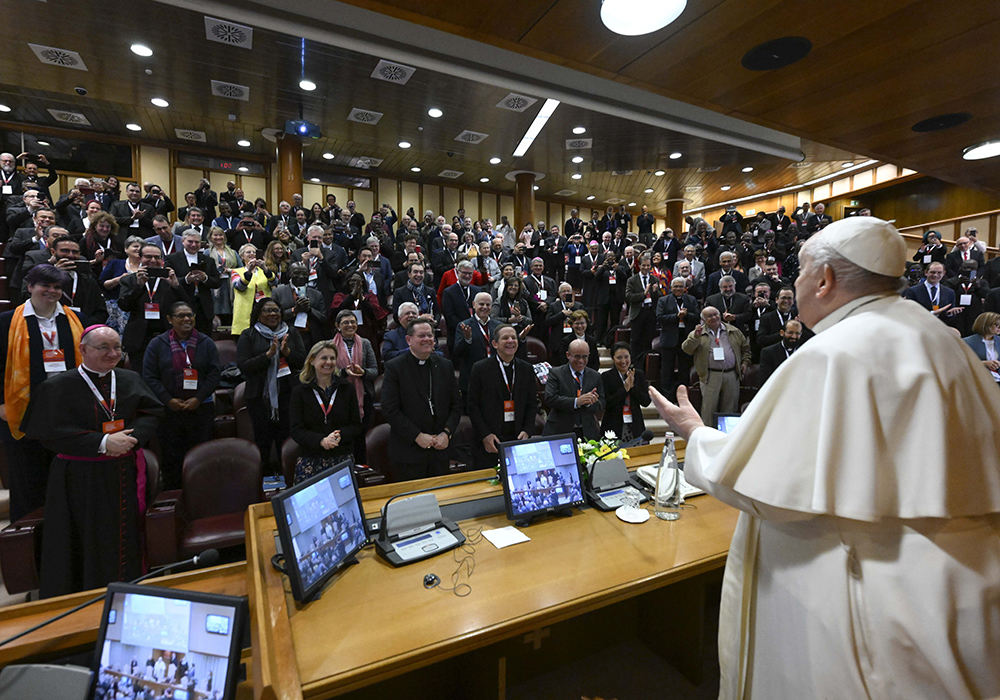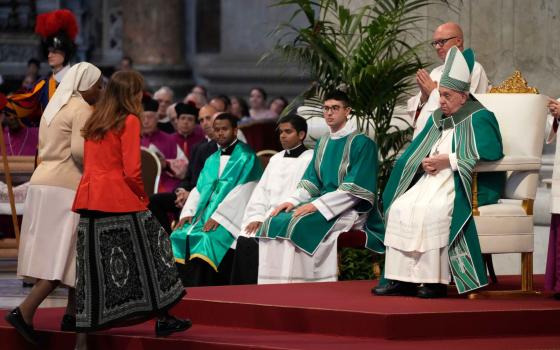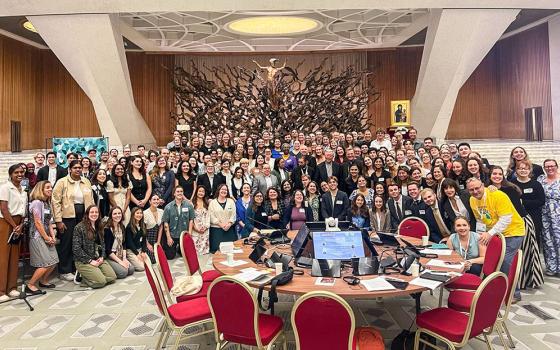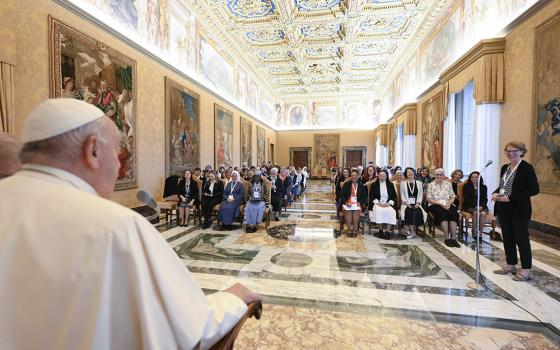
Pope Francis greets participants after speaking at a Vatican conference, "Pastors and lay faithful called to walk together," Feb. 18, in the Vatican synod hall. The meeting was sponsored by the Dicastery for Laity, the Family and Life. This October's meeting on the future of the church will take place in the larger Pope Paul VI audience hall. (CNS/Vatican Media)
During an event earlier this summer inside the Vatican's synod hall, I noticed that the restrooms just off of the main exit included eight stalls for men and two for women.
In a church dominated by an all-male hierarchy, this makes sense. When the new synod hall was inaugurated in 1971, it was likely inconceivable that a venue designed for semi-annual meetings of Catholic bishops from around the world would need to accommodate the needs of women, except perhaps a translator or two.
That's why when Pope Francis extended the participation of the synod to include lay members — with a right to vote on the synod's final document — it seemed likely that the venue for the gathering would likely change, as was announced on July 7, along with names of more than 400 participants that will take part in one of the most closely watched events in the life of the church since the Second Vatican Council.
While the synod hall utilizes stadium-style seating, with cardinals on the first rows, followed by bishops and then priests and with lay theological experts typically seated furthest back, this October's meeting on the future of the church will take place in the larger Pope Paul VI audience hall.

Pope Francis greets participants at a Vatican conference, "Pastors and lay faithful called to walk together," Feb. 18, in the Vatican synod hall. The meeting was sponsored by the Dicastery for Laity, the Family and Life. (CNS/Vatican Media)
The space that can hold over 6,000 pilgrims for papal audiences during colder temperatures will be transformed into a venue for small-group, roundtable discussions — though there are still discussions inside the Vatican these days on how the "dignity" of the cardinals will be represented in this new arrangement.
Of the 363 members who will be able to vote at this October's synod, 54 are women and more than a quarter of all the voting members are non-bishops — both historic firsts.
After seven continental gatherings, the issue of the laity, and in particular, the role of women in the church, emerged in every corner of the globe as pressing concerns to be addressed with at the meeting.
And if one can pinpoint any major motivation for these sweeping synodal changes, one needs to look no further than a November 2021 meeting in Mexico, marking the first ever ecclessial assembly of the Latin American church, which served, in part, as a laboratory for what might play out here in Rome this fall. It was organized by the Latin American bishops' council, known as CELAM.
No longer just an assembly of bishops, over 1,000 delegates — a mix of virtual and in person, and including lay men and women — gathered just north of Mexico City at the pope's initiative with what one of the participants, Austen Ivereigh, described as "in a synodal way, with the people of God as the protagonist."
On hand for the occasion were also top officials from the Vatican's synod office, who got a firsthand look at what the pope's idea of synodality might look like in action.
Emilce Cuda, an Argentine theologian who serves as secretary of the Vatican's Pontifical Commission for Latin America, told me that "the ecclesial assembly of Latin America should not be considered as an isolated event but as the result of a long process that began with the Second Vatican Council" — as, indeed, is Francis' prioritization of the synodal process as his major vehicle for implementing church reforms.
I asked Cuda, who also participated in the Mexico meeting, how the developments in the upcoming synod plans have been shaped by the Latin America ecclessial gathering and, like Ivereigh, she pointed to the inclusive, missionary nature of the event which gave it its distinctiveness and has influenced the current proceedings at the Vatican.
"No one but the people of God — as the historical subject of communion, participation and decisive mission in that continent — can take credit for the creativity and the victory of synodality as an effective reality of the Latin American church," she said.
"This is a communitarian experience that emerges from the grassroots, which is why it cannot be translated into other contexts outside of a living experience," she added.
As Ivereigh wrote in America magazine after that meeting — which also included more than 50 small groups for discussions and discernment — the premise of the ongoing synod process, like the Latin American ecclessial gathering, is that "the church must now convert its authority and structures to create space and formation opportunities for the people of God to participate, assemble and discern."
A change of venue, seating (and bathrooms), and more are now underway here in Rome ahead of the October meeting. To be determined is whether the symbolic changes now lead to substantive ones, as well.







